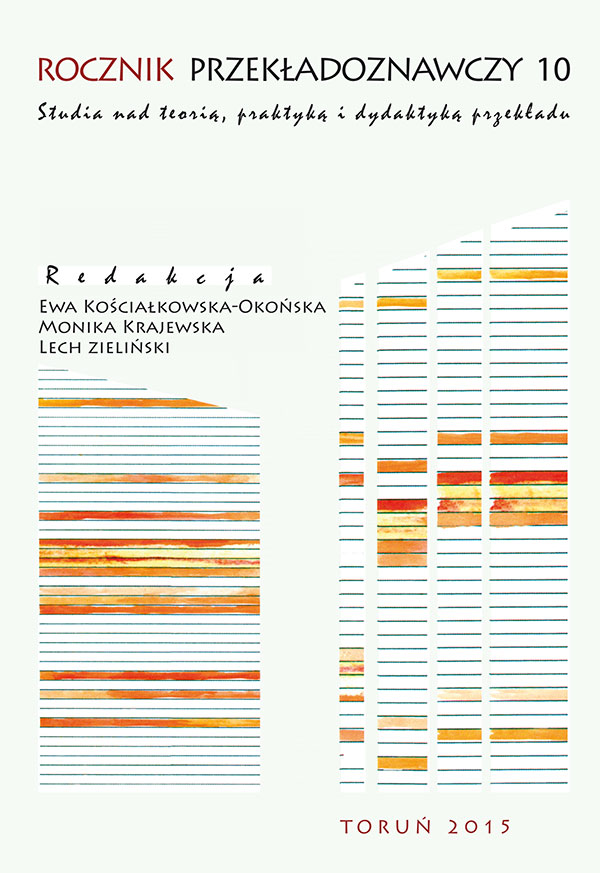Medical texts: traps for the sworn translator
DOI:
https://doi.org/10.12775/RP.2015.007Keywords
medical texts, terminology, specialist language, translation competenceAbstract
Medical translation has been an area of an increased growth in the demand for translation services. It is considered to cover an extensive variety of genres, starting from hospital discharge reports, epicrises, specialist articles in medical journals, patient information leaflets (PILs) or instructions for use (IFU). It also has entered the area of activity of sworn translators due to e.g. migration or Poland’s membership in the EU and resultant EU-law implementation procedures (i.e., implementation of the Medical Devices Directive 93/42/EEC) and commercialisation of medical devices, thus generating the need to deal with an array of texts from the entire realm of various fields of medicine, and related disciplines (pharmacy, pharmacology, biology, etc.). Sworn translators are therefore facing difficulties and at the same time challenges, among which most important are the lack of medical knowledge, medical terminology (including acronyms and abbreviations) or medical phraseology in general. This entails the development of a new professional approach towards proceeding with such tasks, and requires constant improvement of skills and knowledge. The priority of the translator while translating medical texts is the complexity of the original, embracing both complex terminological content as well as form with certain features typical of technical (scientific) texts in general. In the article the utmost significance of the translator’s specialist knowledge and competence is underlined and typical problem areas are presented. The absence of those two factors is reflected in practical examples which were analysed in terms of their correctness and terminological accuracy.
References
Beeby, A., 2000, „Choosing an Empirical-Experimental Model for Investigating Translation Competence: The PACTE Model”, [w:] Intercultural Faultlines. Research Models in Translation Studies I. Textual and Cognitive Aspects, M. Olohan (red.), Manchester, s. 43–55.
Bell, R., 1991, Translation and Translating. Theory and Practice, London–New York.
Fischbach, H., 1998, Translation and Medicine, Amsterdam–Philadelphia. http://dx.doi.org/10.1075/ata.x
Hansen, G., 1997, „Success in Translation”, [w:] Perspectives: Studies in Translatology, nr 5(2) s. 201–210.
Hatim, B., Mason, I., 1997, The Translator as Communicator, London–New York.
Hoof van, H., 1998, „The Language of Medicine: A Comparative Ministudy of French and English”, [w:] Translation and Medicine, H. Fischbach (red.), Amsterdam–Philadelphia, s. 49–65.
Kasprowicz, M., 2010, „Handling Abbreviations and Acronyms in Medical Translation”, [w:] Translation Journal, vol. 14, nr 2, http://translationjournal.net/journal/52abbreviations.htm (dostęp: 15 grudnia 2013 r.).
Kiraly, D., 1997, „Think-Aloud Protocols and the Construction of a Professional Translator Self-Concept”, [w:] Cognitive Processes in Translation and Interpreting, J.H. Danks i in. (red.), London, s. 137–160.
Kiraly, D., 2000, A Social Constructivist Approach to Translator Education. Empowerment from Theory to Practice, Manchester.
Kościałkowska-Okońska, E., 2012, „Kompetencja tłumaczeniowa: modele teoretyczne a rzeczywistość”, [w:] Tłumacz: sługa, pośrednik, twórca?, M. Guławska-Gawkowska, K. Hejwowski, A. Szczęsny (red.), Warszawa, s. 119–129.
McMorrow, L., 1998, „Breaking the Greco-Roman Mold in Medical Writing: The Many Languages of 20th Century Medicine”, [w:] Translation and Medicine, H. Fischbach (red.), Amsterdam–Philapdelphia, s. 13–27.
Neubert, A., 2000, „Competence in Language, in Languages, and in Translation”, [w:] Developing Translation Competence, Ch. Schaffner, B. Adab (red.), Amsterdam, s. 3–18.
Nord, Ch., 1991, Textanalyse und Ubersetzen, Heidelberg.
O’Neill, M., 1998, „Who Makes a Better Medical Translator: The Medically Knowledgeable Linguist or the Linguistically Knowledgeable Medical Professional? A Physician’s Perspective”, [w:] Translation and Medicine, H. Fischbach (red.), Amsterdam–Philadelphia, s. 69–80.
PACTE 2003, „Building a Translation Competence Model”, [w:] Triangulating Translation: Perspectives in Process Oriented Research, F. Alves (red.), Amsterdam, s. 43–66.
PACTE 2000, „Acquiring Translation Competence: Hypotheses and Methodological Problems in a Research Project”, [w:] Investigating Translation Competence, A. Beeby, D. Ensinger, M. Presas, Amsterdam, s. 99–106.
PACTE 2009, „Results of the Validation of the PACTE Translation Competence Model: Acceptability and Decision Making”, [w:] Across Languages and Cultures, vol. 10, nr 2, s. 207–230.
Resurreccio, V.M., Davies, M.G., 2007, Medical Translation Step by Step, Manchester.
Risku, H., 1998, Translatorische Kompetenz. Kognitive Grundlagen des Ubersetzens als Expertentatigkeit, Tubingen.
Toury, G., 1995, Descriptive Translation Studies and Beyond, Amsterdam.
http://dx.doi.org/10.1075/btl.4
Dyrektywa 93/42/EWG dotycząca wyrobów medycznych (Medical Device Directive) z dn. 14 czerwca 1993 r.
Dyrektywa 98/79/WE dotycząca wyrobów medycznych do diagnostyki in vitro (In Vitro Diagnostics Directive) z dn. 27 października 1998 r.
Dyrektywa 90/383/EWG dotycząca wyrobów aktywnego osadzania (Active Implantable Device Directive) z dn. 20 czerwca 1990 r.
Dyrektywa 2001/83/WE dotycząca produktów leczniczych stosowanych u ludzi (Human Medicines Directive) z dn. 6 listopada 2001 r.
Downloads
Published
Issue
Section
Stats
Number of views and downloads: 833
Number of citations: 0



